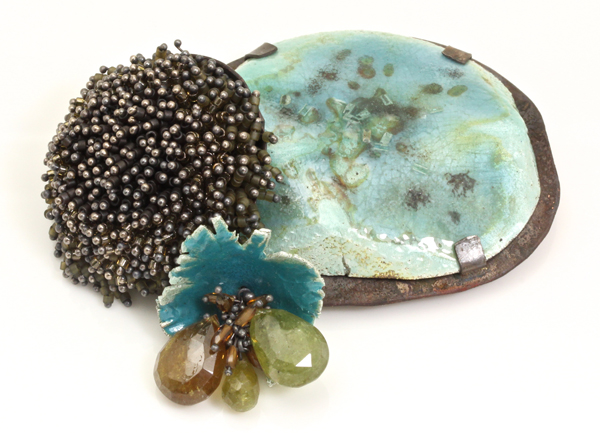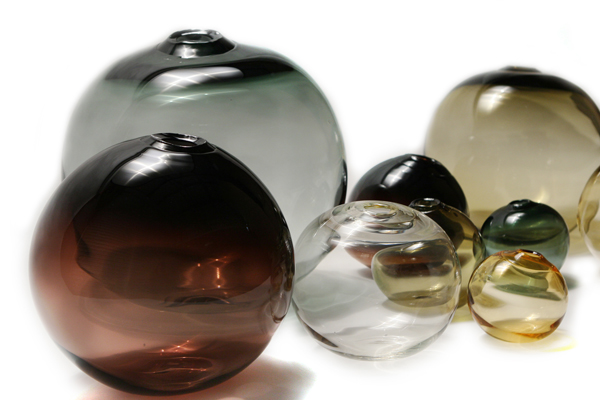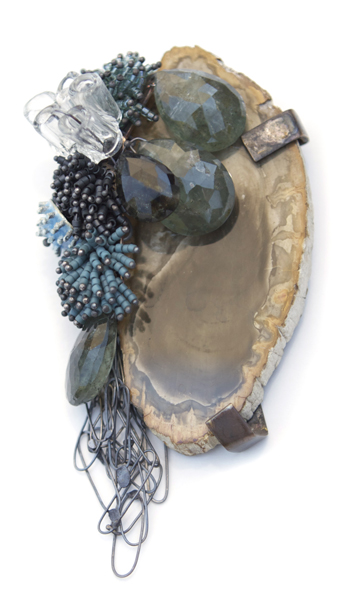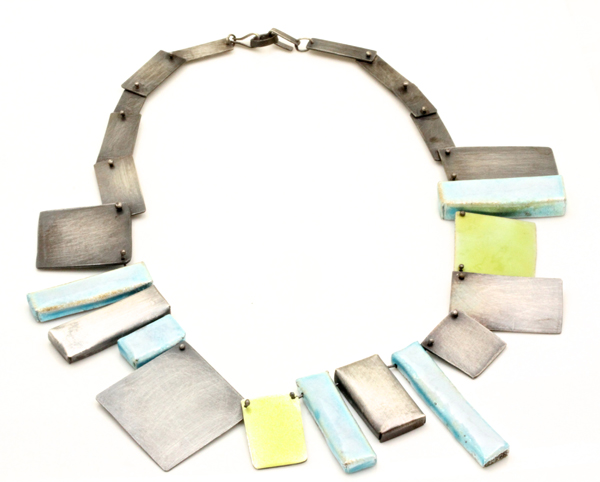
Susan Cummins: What is the story of your journey to becoming a jeweler?
Karen Gilbert: I became a jeweler by accident. I was a student at California College of Arts and Crafts in the painting department when I took an elective in the metals department and became mesmerized by the material of metal. I loved drilling it, sculpting it, torching it—all the tactile qualities appealed to me. I switched my major, and at the same time, became involved in the glass department. The two materials had the immediacy that I needed. I love to work quickly and to respond to my materials as I am working. After school, I worked for numerous jewelers, and that led me into creating wearable pieces. I loved that people actually wanted to buy and wear what I created, and that the relationship of maker and collector really gives meaning to art.
And what is the story of your journey to becoming a gallery owner in the town of Healdsburg, California?
Karen Gilbert: Healdsburg was chosen for the physical beauty of the location for our family and a real sense of possibility, along with its potential built-in clientele for a gallery. With luck, I met Katrina Schjerbeck, who also had passion for art as well as seeing the potential for a Healdsburg gallery, and we really needed each other to make a gallery work. I had the contacts and information on curating for the artists, and Katrina had the ability to manage and oversee the vision.

And what is the story of the collaborative design studio SkLO you started with Pavel Hanousek and Paul Pavlak?
Karen Gilbert: Through the gallery, I met our SkLO business partner Pavel Hanousek, who imports Czech glass from master glass artists in the Czech Republic. The aesthetics of his business were in desperate need of updating. My husband and I joined him, re-branded the business, and now are owners and designers of a glass-based design company. It has been a fascinating challenge to approach work as a designer instead of as the maker. What I love about SkLO is being able to work within one of the world’s great craft traditions—Czech glassblowers—yet having the freedom to make work that does not put technical skill before overall concept and design. Along with my husband Paul Pavlak, I have the opportunity to sculpt the entire vision of the company. It is a huge challenge that involves business savvy as well as creativity. SkLO is successfully growing and is finding a receptive market and critical acclaim.
You are super busy. How do you find time to make jewelry? How do you organize your life?

Karen Gilbert: My time is very tight. I have gone from a relaxed artist lifestyle to being a mother and owner of three businesses. I need a lot more structure in my life. I get up early, and I stick to a routine to get it all done. I think this is changing my work and the visual language that I see in my head, so it is an interesting new path. Jewelry has a much smaller part in my week, but when I am in the studio, it is still a really important time.
Does working with SkLO influence your jewelry designs? How?
Karen Gilbert: I am sure it does. Like I mentioned, it creates more structure, but it also needs to be thought about in terms of being a cohesive body of work. We talk a lot about branding and the language and look of SkLO being something someone knows when they see it. We are aware of this language but also conscious of keeping the audience on their toes. We don’t want to follow the trends, but to pay homage to them and to reflect on our modern society. With my jewelry, it is the same, yet a bit more of a personal commentary. I think of more personal issues with my own work, and with SkLO, I consider more universal issues of design.
This body of work you are showing at Shibumi seems to be a step away from work you have done in the past. There is less glass and more enamel, for example, and the designs are simpler. What is going on here?
Karen Gilbert: I think my influences are shifting. It sort of goes back to the question of time and structure. I personally love very minimalist artwork, but find that my mind does not work in those terms. I am trying to refine and make myself simplify without taking the depth away from the work. Sometimes the pieces want more, sometimes they want less. I am trying to create both dialogues. Also, enamel is just another form of glass that simply alters my technique. I love the endless colors that enamel allows. In the past, I have found it frustrating to use enamel because I don’t have as much control or ability to create my desired effect. I have chosen to really push and experiment with torch enameling, and I enjoy the process, seeing how far I can push it. I feel as though I am just getting started with these new techniques.

What do you think your jewelry does best?
Karen Gilbert: I really like the way my jewelry looks on people. It moves and is wearable in a way that can compliment an individual’s style. I like the tactile quality, that it is very three dimensional, and that almost every piece is different.

Karen Gilbert: It is nice having April to talk to about our shared experiences. I think having a gallery is an additional creative outlet that allows me to not feel like I always have to be producing in the studio. I love to see new work come in and fit it into our aesthetic. It is adding another stroke of paint to the painting, moving it around, and tweaking it to tell our story. I also can get excited about selling other people’s work. I enjoy seeing someone fall for another artist’s work as much as my own. It is a business that takes a ton of time and work. It may seem like galleries just get the work and sell it, but every artist, every piece, takes a lot of time and attention to get it ready to sell and to find the right buyer. At Gallery Lulo, I am fortunate to have a great partner in Katrina Schjerbeck.
Thank you.





